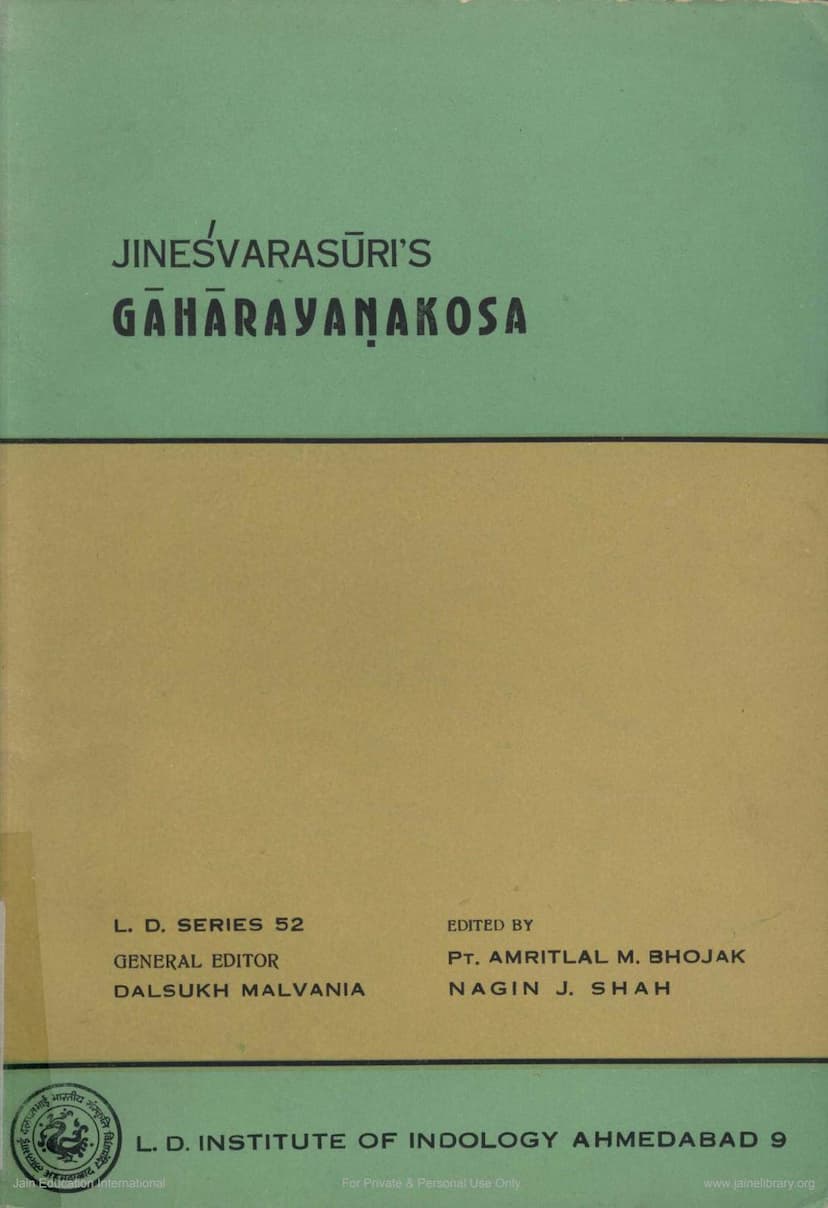Gaharayankosa
Added to library: September 1, 2025
Loading image...

Summary
This document summarizes the Jain text "Gaharayanakosa" (also referred to as Gāthāratnakośa), compiled by Jineśvarasūri in the 13th century of the Vikrama Era. The work is a collection of Prakrit verses (gāthās) by various poets anterior to Jineśvarasūri. The L. D. Institute of Indology, Ahmedabad, published this text in 1975.
Here's a breakdown of the key aspects:
Content and Structure:
- Vast Collection: The Gaharayanakosa is an anthology comprising 58 sections, known as Prakrama.
- Subject Matter: It covers a wide range of themes, similar to other Sanskrit and Prakrit anthologies. The collection includes:
- Religious prayers (Jina, Vishnu, Maheshvara, Sarasvati).
- Poetic praise and discussions on poetry.
- Descriptions of natural elements like the sea, fire, seasons.
- Portrayals of various characters and situations: kings, nobles, villains, wealthy, poor, lovers, courtesans, etc.
- Sections on specific topics like Krishna's sports (Krishnakrida), poetic riddles (hrali), and detailed descriptions of women.
- Jainistic Elements: While compiled by a Jain monk, the work is not exclusively Jainistic, with only the first section dedicated to Jina's praise. It also includes prayers to other deities.
- Number of Gāthās: The compiler stated the collection contained 800 gāthās, equivalent to 1000 Anushtubh verses. The manuscript used for the edition contained 822 gāthās, with the printed edition having 837 gāthās, indicating a discrepancy in numbering in the original source or the printing process.
- Compilation Details: Jineśvarasūri compiled this anthology in the village of Bhālijja (modern Bhalej) in Vikrama Samvat 1251 (1251 AD).
Editorial Aspects:
- Manuscript Used: The primary manuscript utilized for editing is from the Ac. Kṣantisürisvara Collection at the L. D. Institute of Indology, Ahmedabad (Serial No. 940). This manuscript is described as a paper manuscript from the late 17th or early 18th century V.S., with a good condition and legible script. It contains scholarly additions and corrections made by the scribe, Up. Vinayavijayaji, who is identified as a notable scholar.
- Additional Works: Along with the Gaharayanakosa, the volume also includes two other "tiny Subhāṣitagathasangrahas":
- Subhasiyagahasangaho (from the Santinathaji Jaina Jñana Bhaṇḍāra, Cambay, Serial No. 107), possibly from the first half of the 13th century V.S.
- Subbasiyapajjasangaho (from the same Bhandara, Serial No. 267), likely from the first half of the 14th century V.S.
- Appendices: The edition includes appendices that list important words from the three anthologies and identify gāthās common to the Gaharayanakosa and Vajjālagga.
- Editorial Effort: The preface highlights the painstaking efforts of the editors, Pt. Amritlal M. Bhojak and Dr. Nagin J. Shah, in making the edition useful, aiming for a flawless text, and providing an informative introduction.
Significance:
- Preservation of Verses: The importance of such gāthāsangrahas is to rescue a large number of fleeting verses from oblivion.
- Prakrit Literature: The publication is seen as a valuable contribution to the study of Prakrit language and literature, making accessible the wisdom and sentiments of common people, as Prakrit was the language of the masses.
- Comparison with Vajjālagga: The text shares nearly a hundred gāthās with the Vajjālagga, another significant Prakrit anthology.
- Author's Lineage: The compiler, Jineśvarasūri, mentions his spiritual lineage as Sri Silasuri -> Sri Dharmasuri -> Sri Sarvadevasuri -> Sri Candraprabhasuri -> Sri Jinesvarasuri. The introduction also notes Jineśvarasūri's active period, mentioning his installation of an idol in V.S. 1288.
In essence, the Gaharayanakosa is a significant repository of Prakrit poetry from the medieval period, offering insights into the language, culture, and societal norms of that era, preserved and meticulously presented by the L. D. Institute of Indology.